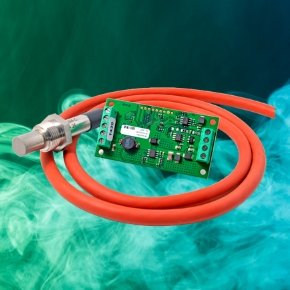
Zirconia oxygen sensors are used in a variety of applications and industries to measure the air-to-fuel ratio in combustion, automotive, oil, gas, and bio-mass environments.
How does a Zirconia Oxygen Sensor Work?
 The Zirconia Oxygen Sensor utilizes a core containing two porous electrodes which are made of Zirconia ceramic elements combined with a thin layer of platinum. This element is what gives the sensor the ability to control the air-fuel ratio.
The Zirconia Oxygen Sensor utilizes a core containing two porous electrodes which are made of Zirconia ceramic elements combined with a thin layer of platinum. This element is what gives the sensor the ability to control the air-fuel ratio.
In order to control this ratio, one side of the electrode is exposed to the air and the opposite side is exposed to an exhaust gas.
The results provide a precise voltage which is accumulated in response to the difference in overall oxygen concentration.
Another fascinating feature
The small zirconium dioxide based element at the heart of the Zirconia Oxygen Sensor does NOT require a reference gas.
This unique capability creates the innovative sensor we have today, and further removes limitations in the environment which the sensor can be operated in.
Regardless of high temperatures, humidity and oxygen pressures, the possible applications are nearly endless, making the sensor a highly valued product for integration applications.
Let's Discuss the Zirconia Oxygen Sensor Core
Taking a look at the actual core of the Zirconia Oxygen Sensor you will notice the "heart" of the sensor, called the "sensing cell".
This unique cell is what contains the two zirconium Dioxide (ZrO2) electrodes.
The dual electrodes provide stability and consistency which enables the electrodes to separate the O2 and the oxygen ions to then be carried in and out of the ZrO2.

The two ZrO2 squares are separated by a platinum ring which forms an airtight, sealed sensing chamber. At the outer surfaces, there are two further platinum rings which along with the center platinum ring, provide the electrical connections to the actual cell.
Two outer alumina (Al2O3) discs filter and prevent any ambient particulate matter from entering the sensor and also remove any "un-burned" gas concentrations.
This prevents contamination of the cell which may lead to unstable measurement readings.
In Figure 3-2 below, it shows a cross-section of the sensing cell with all the major components highlighted.

Overall, the Zirconia Oxygen Sensor System's cell assembly is surrounded by a heater coil which produces the necessary 700°C required for operation.
The cell and heater are then housed within a porous stainless steel cap to filter larger particles and dust and also to protect the sensor from mechanical damages.
In Figure 3-3 below, it also shows the complete sensor assembly which you will notice on the Zirconia Oxygen Sensor System.

There are a variety of things to consider prior to choosing any Zirconium Dioxide Oxygen (O2) Sensor or interface, such as cap, housing, sensor type and overall application.
Sensors such as the Zirconium Oxygen Sensor System encompass a majority of these overall behaviors, are rich in conditions, and provide easy integration into a variety of environments.
The Working Principle of Zirconia Oxygen Sensors
Zirconia oxygen sensors work based on the electrochemical properties of zirconium dioxide (ZrO2), a ceramic material. The core mechanism involves a thin layer of zirconia coated with electrodes on both sides, typically made of platinum. This sensor operates at high temperatures, which allow the zirconia to conduct oxygen ions. When exposed to different oxygen concentrations on each side of the zirconia membrane—usually the exhaust gas and ambient air—a voltage is generated due to the movement of oxygen ions through the ceramic layer.
This voltage output is proportional to the difference in oxygen concentration between the two sides of the sensor. The greater the discrepancy in oxygen levels, the higher the voltage generated. This signal is then interpreted by an engine management system or control device to monitor or adjust oxygen levels in various applications, such as automotive exhaust systems for efficient combustion and emissions control. The sensor’s fast response time and high accuracy make it an essential tool in industries requiring precise oxygen level measurements.
Unique Main Features:
- Zirconium dioxide technology, Measuring 0.1-25% or 0.1-100% O2
- Interface electronics included
- Integral heating element
- Linear output signal
- Heat resistant, allowing severe high temperature environments
- Rugged stainless steel construction, for use in aggressive environments
- Pre-calibrated directly from the facility, does not require further calibration
- Suitable for applications in combustion control, automotive, small engines, agricultural, industrial and many others.
Key Applications and Advantages of Zirconia Oxygen Sensors
Zirconia oxygen sensors are widely used across various industries due to their high precision and reliability in measuring oxygen levels. One of the most prominent applications is in automotive engines, where they play a crucial role in monitoring exhaust gases to optimize fuel-to-air ratios. This helps improve combustion efficiency, reduce emissions, and ensure compliance with environmental regulations. Beyond the automotive sector, zirconia oxygen sensors are also essential in industrial processes such as combustion control in power plants and kilns, where precise oxygen monitoring is necessary for energy efficiency and pollution control.
The advantages of zirconia oxygen sensors lie in their durability, responsiveness, and ability to operate at high temperatures. Their robust design allows them to withstand harsh environments and maintain accuracy over long periods, making them ideal for continuous monitoring. Additionally, their fast response time enables real-time adjustments in processes, which is critical for applications where oxygen levels must be tightly controlled. The combination of these benefits makes zirconia oxygen sensors a valuable tool for enhancing efficiency, reducing energy consumption, and supporting environmental sustainability.
References:
http://co2meters.com/Documentation/Other/Zirconia_Sensors_3.pdf
https://www.sstsensing.com/what-is-a-zirconium-dioxide-oxygen-sensor/
https://en.wikipedia.org/wiki/Oxygen_sensor
https://www.co2meter.com/blogs/news/how-does-an-oxygen-sensor-work#zirconia







